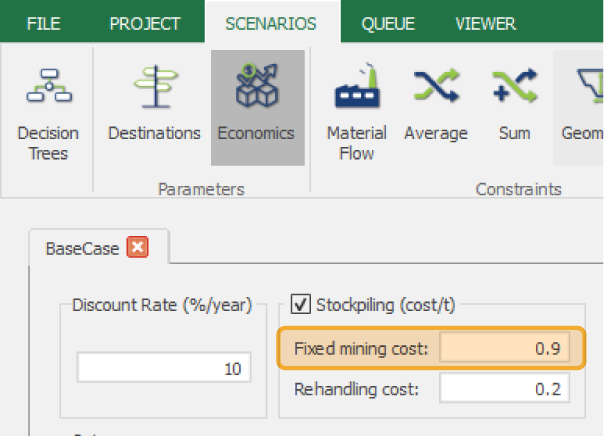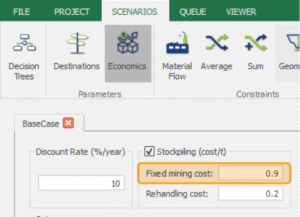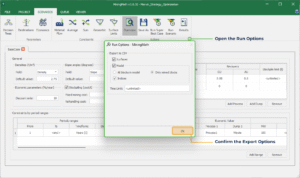Variable Mining Costs
Highlights
Fixed mining costs simplify early-stage economic modeling, but they may not reflect real operational variations. MiningMath offers flexible ways to approximate variable costs through customized inputs and iterative workflows.
- Users can assign block-by-block mining costs via the “Other” field, enabling cost analysis without altering the optimization logic.
- Iterative re-imports or manual edits in CSV outputs help refine NPV, especially for stockpiled blocks.
- MiningMath’s open structure supports transparent post-processing and integration with external tools, unlike rigid black-box systems.
MiningMath was conceived with some simplifications for current version, such as the fixed mining costs.
How does it work?
The software uses a fixed mining cost, which is incorporated into the economic formulation at an early stage. This value is entered through the user interface, enabling the software to recognize and adjust the pre-calculated economic values accordingly. The appropriate discounts are then applied to each block based on its status: whether it is (1) processed, (2) discarded, or (3) stockpiled and later processed. In all cases, mining costs are factored in before processing costs and revenue are considered.
For mined blocks in the stockpiles context, the possibilities for the material flow and their cost calculation are:
Mine-to-process: this is already embedded in the economic formulation.
Mine-to-waste: this is already embedded in the economic formulation.
Mine-to-stock: this is considered the same as the cost for mine-to-waste. However, this is a limitation, since these two costs might not be always the equal due to, for example, different distances at the mine site surface (different haul costs).
Stock-to-process: this considers an additional cost, represented in the user interface by the re-handling cost.
Limitations and alternatives
Mining costs might be defined with some variability for purposes of higher detail. This sections shares some ideas on how to consider variable mining costs, in which some goals are based on different aspects, such as:
- Haul costs, in function of block’s depth and/or the destination site.
- Blasting costs, in function of the rock type.
- Loading costs, in function of a selective mine.
- Supplies and materials, labor costs, among others.
The following steps outline how to add block-by-block mining costs to the block model file and define their average cost within the software.
Prior to the model import, create a column of mining costs by block — including whatever costs are applicable: blasting, haul, loading, etc.
Calculate the Average Mining Cost of all of the blocks.
During the model import, assign the Mining Costs column to the field type Other; MiningMath will export this column along with its output.
Use the Average Mining Cost as the Fixed Mining Cost for the stockpiles.
Run MiningMath.
OPTIONAL for more accurate approximation: analyze the
MinedBlocks.csvfile (orAllBlocks.csv) and calculate the average mining cost just for the stockpiled blocks.OPTIONAL: run MiningMath again, now using the new average mining cost (from step 6) as the fixed mining cost for the stockpiles.
For which the steps are:
Open the MinedBlocks.csv.
Edit the stocked blocks' value to add new costs.
Calculate the NPV manually.
For which the steps are:
Further iterations
This process does not guarantee that the solution will remain unchanged; stockpiled blocks may vary, potentially requiring further iterations for better approximation.
Since stockpiles are treated as a post-processing unit and are not part of the optimization, Option 1 offers a more accurate NPV calculation.
Development notes
The following features are already in our pipeline:
- Optimized Stockpiles: future versions will consider Stockpiles as destinations when optimizing the NPV.
- Varying mining costs: future versions will have a field which varies by block (similar to how density, slope and recoveries field are already implemented).
We are collaborating with a partner to develop a calculator and post-processing analysis tools for future integration with MiningMath. For more information, please contact our support team or read about our future overview.








